Tanks in the Japanese Army
This article deals with the history and development of tanks of the Japanese Army from their first use after World War I, into the interwar period, during World War II, the Cold War and modern era.
Overview
The First World War established the validity of the tank concept. After the war, many nations needed to have tanks, but only a few had the industrial resources to design and build them. During and after World War I, Britain and France were the intellectual leaders in tank design, with other countries generally following and adopting their designs. Japan took interest in tanks and procured some of the foreign designs, and then went to build its own. The designs built were light tanks which Japan used in China in the mid-1930s against opposing infantry in campaigns in Manchuria and elsewhere in China, as the Chinese National Revolutionary Army had only three tank battalions consisting of Vickers export tanks, German PzKpfw I light tanks, and Italian CV33 tankettes[1] to oppose them. Because of the Imperial Japanese Army emphasis on the infantry at the expense of all other branches, armored vehicle development and fielding suffered as a result; a shift to designs with heavier armor and larger guns to fight against the larger tanks of the Allies came too late for the Japanese to field superior tanks on the battlefield.
After the Second World War, the Supreme Commander of the Allied Powers dismantled all military manufacturing and development facilities in Japan, causing Japan to lose the technology base required to manufacture tanks and armored vehicles. However, due to the outbreak of the Korean War, SCAP ordered Japan to re-militarize, forming the Japanese Ground-Self Defense Force and providing M4A3E8 Sherman and M24 Chaffee tanks (an initial plan to provide M26 Pershings was abandoned in the face of State Department opposition). For various reasons, including obsolescence of the tanks in JGSDF service at the time, the JGSDF in 1954 was given the option to either purchase new American built M46 Pattons and later the M47 Patton or develop its own Main Battle Tank (MBT). The JGSDF decided to develop its own tank, which resulted in the development of the current range of modern Japanese tanks built by Mitsubishi Heavy Industries.
Developments influencing Japanese tank design
The Imperial Japanese Army (IJA) did not have tanks of its own in World War I, so initially it started out by purchasing foreign tanks for evaluation during that war, and then began developing its own designs. The Japanese didn't embrace the tank, as it didn't have the cavalry tradition that the other countries that developed the tank more extensively had. In traditional Japan, cavalry was used for reconnaissance in the mountainous countryside, so at first the designs were constrained by the tank’s infantry support role. Inspired by European designs, the Japanese tank program designs and developed the tanks which facilitated their campaigns in China prior to the Pacific War. They introduced many innovations as they built their designs, including bell-crank suspensions, were pioneers in amphibious tanks, and the use of diesel engines as they were less likely to catch on fire versus the regular gas engines that were being used at the time.
Naming system for tanks
The Japanese system for naming tanks seems difficult to a Westerner, although it is quite logical. Like all weapons, the year of introduction is the first criteria. That year is computed on the historical calendar of Japan, starting 660 years BC. A tank Type 92 was thus introduced in 1932, the year 2592 of the Japanese calendar (only the two last digits counts). The problem is that several weapons or tanks can be introduced the same year. The Japanese used ideograms to differentiate further the various weapons. The ideogram "Chi" meant a medium tank, "Te" a tankette; "Ke" an assault gun, "Ho" a self-propelled gun, "Ka" an amphibious tank. There was a second ideogram to distinguish the models. The Type 97 Chi-Ha is a medium tank introduced in 1937, the Type 2 Ke-To is a light tank introduced in 1942. There is sometimes a surname to supplement or replace the ideograms. The "Type 97 Shinhoto Chi-Ha" is a variation of the medium tank Chi-Ha with a new turret (meaning of the word Shinhoto). The Type 95 had the surname "Ha-Go" given by the builder of the tank.
Post World War I

After World War I, many European countries attempted to mechanize their cavalry. In parallel, Japanese cavalry also experimented with a variety of armored cars with limited success. These wheeled armored cars were not suitable for most operations in Manchuria, due to the poor road conditions and severe winter climate. Japan's army (like the US, French, British and Russian armies) tried various methods to integrate modern armor into their traditional horse cavalry formations.[2]

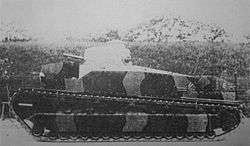
The Imperial Japanese Army obtained a variety of models from foreign sources. At the time, the Japanese did not have any indigenous tank production capability and until they could set up the factories and infrastructure continued buying from foreign sources. These models included one British Heavy Mk IV and six Medium Mark A Whippets, along with thirteen French Renault FTs (later designated Ko-Gata Sensha or "Type A Tank"). The Mk IV tank was purchased in October 1918 while the Whippets and Renaults were acquired in 1919.[3] With this beginning, the Imperial Japanese Army establish an armored force in 1925. In 1929, the Imperial Japanese Army purchased the replacement for the Renault FTs; they acquired from France, 10 of the Renault NC1 (designated Otsu-Gata Sensha or "Type B Tank"). The Imperial Japanese Army also purchased several Vickers 6-Ton tanks and Carden Loyd tankettes from the British and used these as a basis for further development.[4]
Building tanks of their own met several problems, as Japan's priority tended to be with naval procurements so production for tank steel would have been on a lower level. However, they finally began designing tanks by the mid-1920s. It was decided to build two different experimental tanks for evaluation, which differed from the conventional practice of giving the same specifications to several competitors and having each make a prototype. Development of the first Japanese-designed tank began in June 1925. A team of four engineers in the motorcar group of the Technical Bureau participated in the development, including a young army officer, Major Tomio Hara who later became the head of the tank development department and would rise to the rank of General. The design was finished in May 1926 and the prototype was completed by February 1927.[5] After trials, the IJA decided that the Type 87 Chi-I was too heavy at 20-ton and too slow to be used as its main tank.[6] The design was rejected. A new requirement was issued for a lighter tank, with a nominal 10-short-ton (9.1-metric-ton) weight. The new design was modeled after the Vickers Medium C which had been bought by the Japanese Army in March 1927. By 1929 the prototype of the Type 89 Chi-Ro (Experimental Tank Number 2) was completed.[7][8]
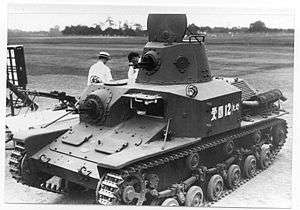
As a result of trials, in 1929 the Japanese decided to proceed with the domestic development of a small vehicle for mobile operations.[9] The initial attempt resulted in the Type 92 Jyu-Sokosha by Ishikawajima Motorcar Manufacturing Company (currently Isuzu Motors). The Type 92 was designed for use by the cavalry for reconnaissance and infantry support. The development of the Type 92 began with a hybrid amphibious car; this had both tracks and wheels and was able to drive in forward and reverse, both in the water and on land. The experiment was not entirely successful, therefore the amphibious car concept was abandoned, and the design was changed to a tracked vehicle for land use only.
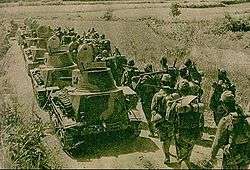

The IJA began to focus on tankettes. The development was given to Tokyo Gas and Electric Industry (later known as Hino Motors) in 1933, and an experimental model was completed in 1934. It was a small light tracked vehicle with a turret armed with one machine gun.[10] The design was standardized as the Type 94 tankette. It entered service in 1935. The Type 94 was later superseded by the Type 97 tankette. They were "tailored" vehicles for operating in China.[11] There the ultra-light tanks, with a weak armament and armor but highly mobile, were highly successful. No antitank opposition was to be feared. By the late thirties, it became clear that that kind of vehicles would not be very useful against a more serious enemy. The development of tankettes was stopped.
By 1932, Mitsubishi Heavy Industries was producing an air-cooled diesel engine that was suitable for tanks. One major reason that the air-cooled diesel engines may have been preferred was that water was scarce in areas that the Imperial Japanese Army was operating in Mongolia, Manchuria, and North China. This was placed experimentally into a Type 89. This later became known as the Type 89-B medium tank. In 1933 Major Tomio Hara designed the basis of many of the suspensions of future Japanese tanks, the bellcrank scissors which had paired bogie wheels connected by a coil spring.
Japan also built the Type 95 Heavy Tank in 1934, which was the final version of the Japanese multi-turreted designs, that had started back in 1931 with the prototype 18-ton Type 91.[12] Modeled from German and Italian tank designs, this tank featured 3 turrets; the main armament being a 70 mm cannon with a 6.5 mm machine gun also mounted on the main turret. Two addition turrets gave Type 95 yet more firepower: one Type 94 3.7 cm tank cannon was mounted in one auxiliary turret, and the second auxiliary turret featured a 6.5 mm machine gun.[13] Four prototypes were completed before the project was cancelled.[13][14]
In the meantime, a new light tank appeared. The Type 95 Ha-Go, introduced in 1935, would monopolize the stage until 1942. It was by no means a bad design, but its popularity among the crews delayed by a couple of years the introduction of a follower. It is already outdated in 1940. The two models that replaced it after 1942 (the Type 98 Ke-Ni and the Type 2 Ke-To) are only slightly different. A radically new follower, the Type 5 Ke-Ho will not go further than testing.
In the field of amphibious tanks, the Japanese proved more creative. The army built several prototypes before the war (they are the first to experiment with jet propulsion), but none were mass-produced and the whole enterprise is dropped in 1940. After the war brought in the Allies in 1941, then the Navy's began to have interest in amphibious tanks. The Ka-Mi and the Ka-Chi were adaptations of land tanks on which disposable bows and sterns are added to ensure flotation. They did not play a significant role in combat.
World War II
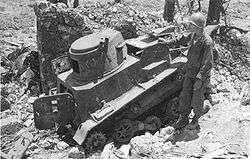
During the battle of Khalkhin Gol, the Japanese Army's 1st Tank Corps consisted of the 3rd Tank Regiment and 4th Tank Regiment; the 3rd Tank Regiment consisted of 26 Type 89s, four Type 97 medium tanks, seven Type 94 tankettes, and four Type 97 Te-Ke tankettes, and the 4th Tank Regiment contained 35 Type 95s, eight Type 89s, and three Type 94 tankettes. In this battle, the Japanese Army's 1st Tank Corps launched an offensive against the Soviet Union's 11th Tank and 7th Armored brigades and suffered heavy losses.
After the Battle of Khalkhyn Gol in 1939 against the Russians which resulted in total defeat for the Japanese Sixth Army, it prompted the Imperial Japanese Army to rethink tactics and formations of armored units along with tank design. Armored production was ramped up from 500 tanks per year to 1,200 and the Japanese decided they needed a better tank gun and developed the 47 mm in response to the Soviet 45 mm guns encountered in combat in 1939. This was placed into the Type 97 and designated the Type 97-Kai a/k/a Type 97 Shinhoto Chi-Ha.[15]
The Japanese generals had made a mistake in their assessment of the tanks used against China, a country whose army had few tanks or antitank weapons. By 1937, Japan fielded 1,060 tanks in 8 regiments, but most were designed for and used in an infantry support role. However, tanks built for this role left the IJA without a tank capable of tank-vs-tank combat, a deficiency that was brought home hard at Khalkin-Gol, a terrible defeat inflicted by the Russians on the Mongolian border in 1939.[15] This also proved fatal later when they faced Allied tanks, as the great majority of the Japanese models were too light, with not enough armament, and obsolete vehicles went on being mass-produced.
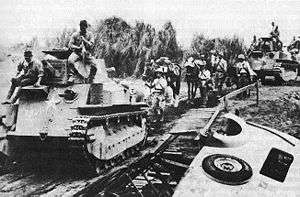
From 1932 onwards, the Type 89 Chi-Ro had been the first Japanese tank to be mass-produced. It remained the standard medium tank until the late thirties. It was outdated before that time. Its follower, the Type 97 Chi-Ha took over and remained the standard type until the end of the war in 1945. Its shortcomings were clear since the Battle of Kalkin Go in 1939 though. The Shinhoto Chi-Ha, the same hull with a new turret to install a better gun appeared only in 1942. While vulnerable to opposing Allied tanks (US M3 Lee/British M3 Grant, M4 Sherman and Soviet T-34), the 47 mm high-velocity gun did give the Shinhoto some fighting chance against them. The 47 mm gun was effective against light tanks and against the sides and rear of the Sherman tank.[16] The Japanese designed some additional models, some were produced in limited numbers (such as the Chi-He or the Chi-Nu) but none were mass-produced.
With the German armor led victories in Europe in 1940, the Japanese changed their deployment and doctrine and organized tank divisions.[15] By 1940 they were the fifth largest tank force in the world behind the Soviet, France, Britain and Germany, but were behind in medium and heavy tanks. However, after 1941 the Japanese focused their industry on building warships and aircraft after the attack on Pearl Harbor brought the United States into the conflict, as priorities shifted to weapons they felt were more important to attack across the Pacific and defend the Empire against the American naval fleet.[17]
So although the Japanese Army widely employed tanks within the Pacific theater of war, the tanks that Allied forces in the Pacific faced were mostly older designs or even obsolete as the most modern Japanese tanks, such as the Type 3 Chi-Nu were delayed by material and production shortages. Even after they started to come out of the factories the idea was to hold them for the defense of the mainland, and not dispersed to the far flung Imperial Japanese Army or Navy forces. Between 1931 and 1945, Japan produced 6450 tanks. Half of them (3300) were made by the Mitsubishi Company. The sub-total of tanks produced between 1940 and 1945 is 4424, i.e. a yearly average comparable to Italy. For a country as large and as industrialized as Japan, that is modest. This being due to the higher priority of steel allocated to the Imperial Navy for warship construction.[18] It changed to a degree in 1944/45, when the homeland became increasingly under direct threat but it was too late. As with many innovative weapons projects launched by Japan in the final years of World War II, production could not advance beyond either small numbers or the prototype stage due to material shortages, and the loss of Japan's industrial infrastructure to the Allied bombing of Japan.[19][20]
Post World War II

After World War II, Supreme Commander of the Allied Powers (A.K.A. GHQ in Japan) seized all military manufacturing and development plants in Japan, making Japan lose the technology to build and manufacture tanks and armoured vehicles (even though the technology was not well developed.) However, due to the Korean War, the Supreme Commander of the Allied Powers ordered Japan to re-militarize, forming armed police forces (National police reserve, later called National security force, then finally Japan ground self-defence force) and provided M4A3E8 Sherman and M24 Chaffee tanks.
The M24, though it was popular amongst the Japanese crews, was inadequate when facing Soviet T-34/85s, as seen in Korea. Thus, as the tanks in the Japan ground self-defence force (JGSDF) service at the time were obsolete/inadequate, the JGSDF was provided with the option of either purchasing the new American built M46 Patton and, later, the M47 Patton or develop their own MBT in 1954. Due to the high cost of purchasing American made tanks, and because the M47 did not meet their requirements, the JGSDF decided on developing their own main battle tank, resulting in the development of the Type 61 tank.
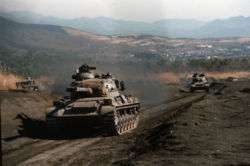
The first test vehicles, STA-1 (completed in December 1956) and STA-2 (completed in February 1957) were built and tested. The results were used to develop the STA-3 (completed in January 1960) and STA-4 (completed in November 1959) in 1960. More improvements were made in 1961 and the deployment of the Type 61 started in the same year.
The initial production rate was low, with only ten tanks produced in 1961 and 1962, increasing to twenty in 1964 and thirty in 1965 and 1966. A total of 250 had been produced by 1970, with production continuing at an increased pace until 1975 when it was terminated. A total of 560 were produced.[21] The main gun of the Type 61 was unstabilized, so firing on the move was impractical, and the vehicle is not fitted with an NBC protection system or deep wading equipment. The JGSDF started studies on a new tank design with Mitsubishi in 1962, as it was realized that the Type 61 would not be able to defeat the latest Soviet designs like the T-62. The tanks were phased out of service in the 1990s with 400 in service in 1990, and 190 in service in 1995. All were decommissioned by 2000, 39 years after their original deployment.[22] From 1980, Type 61's began to be supplemented by the more modern Type 74 MBT.

The first prototype of the Type 74 MBT, designated STB-1, was delivered in late 1968 and underwent a number of modifications until the final prototype designated STB-6 was delivered in 1973. Production finally started as the Type 74 in September 1975, with 225 being delivered by January 1980. Production ended in 1989, with total production running to 893 examples. The gunner's position included a digital fire control computer, fed range data from the commander's range finder. Rounds for the main gun were upgraded from HEP to APFSDS and HEAT-MP.
After the adoption of the Type 74, the Japanese High Command was already looking for a superior, completely indigenous tank design to defeat the Soviet T-72. As a result, development of a prototype as a replacement for the Type 74, the TK-X MBT began between 1976 and 1977 which became the Type 90 tank. The Type 90 was to have replaced the Type 74 outright as the Type 74 was generally outdated even before it entered service, but with the ending of the Cold War these plans were scaled back.

Requirements of the Type 90 were completed in 1980 with two prototypes and a second series of four prototypes was built between 1986 and 1988 which incorporated changes as a result of trials with the first two prototypes. These were armed with the Rheinmetall 120 mm smoothbore gun also fitted to the German Leopard 2 and, in a modified version, in the US M1A1/M1A2 Abrams MBT.
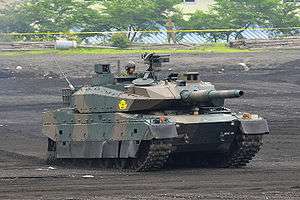
These second prototypes were used for development and then user trials, all of which were completed by 1989, before Japan formally acknowledged the Type 90 in 1990. With the exception of the 120 mm smooth-bore gun, which is made under license from Rheinmetall of Germany, the Type 90 and its subsystems were all designed and built in Japan. It has been complemented by the Type 10, which first entered service in January 2012.[23] The Type 10 has armor that consists of modular components which significantly improves the side armor compared to the Type 90. The Type 10 uses the same 120 mm smoothbore gun as the Type 90.[23]
Overview per tank
Type 87 Chi-I medium tank (experimental 1st tank)
Development of the first Japanese-designed tank began in June 1925. A team of four engineers in the motorcar group of the Technical Bureau participated in the development, including a young army officer, Major Tomio Hara. Major Hara later became the head of the tank development department and would rise to the rank of General. The team started their design of a tank and worked hard to complete the project within the two years allocated. As this was the first tank designed in Japan, they had to begin with almost every component built from scratch.
Hara designed a bell crank scissors suspension which paired the bogie wheels and connected them to a coil spring mounted horizontally outside the hull. This suspension became standard on the majority of Japanese tanks and can be seen on the Type 89 medium tank.
The design was completed in May 1926 and production was ordered to begin at the Osaka Army Arsenal. At the time, there was little heavy industry allocated to the production of motor vehicles in Japan, so there were significant difficulties creating the prototype. The prototype was completed by February 1927, within the required period and ready for trials.[5] Many IJA generals attended the trials of the Type 87 Chi-I, however, it was 20-ton and under-powered by a 140 hp engine.[6] The weight of the initial prototype and its low speed did not impress the Imperial Japanese Army General Staff Office, and a new requirement was issued for a lighter tank, with a nominal 10-short-ton (9.1-metric-ton) weight. The new design was modeled after the Vickers Medium C which had been bought by the Japanese Army in March 1927.[24]
Type 94 tankette
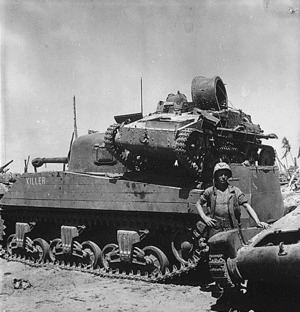
The IJA ordered some tankettes from Great Britain, along with some French vehicles and field tested them.[25] The IJA determined that the British and French machines were too small to be practical, and started planning for a larger version, the TK model, or Special Tractor. It was reclassified as the Type 94 (Type 2594; tankette) and was designed for reconnaissance,[26] but could also be utilized for supporting infantry attacks and transporting supplies.[11][10]
The initial attempt resulted in the Type 92 Jyu-Sokosha for use by the cavalry. However, Japanese infantry commanders felt that a similar vehicle would be useful as the support vehicle for transport, scout and communications within the infantry divisions,[27] and close support in infantry operations.
It was a small light tracked vehicle with a turret armed with one machine gun. For cargo transportation it pulled an ammunition trailer.[28] It was given the name Tokushu Keninsha ("Special Tractor"), abridged to "TK". After trials in both Manchukuo and Japan, the design was standardized as the Type 94 tankette. It entered service in 1935. The lightweight Type 94 was "tailored" for operating in China[11] and proved effective in Manchuria and elsewhere as the Chinese National Revolutionary Army consisted of only three tank battalions to oppose them. As with nearly all nation's tankettes built in the 1920s and 1930s, they had thin armor and could often be penetrated by standard small arms fire.[29]
One interesting variant for the Type 94 tankette was as either a gas scattering vehicle or disinfecting vehicle. The Type 94 Disinfecting Vehicle and Type 94 Gas Scattering Vehicle was a Type 94 tankette adapted to chemical warfare. The tankette was used as a "tractor", where it would pull either a configured independent tracked mobile liquid dissemination chemical vehicle or a respective tracked mobile disinfecting anti-chemical agents vehicle.[30]
The Gas Scattering Vehicle version could scatter mustard gas chemical agent with an 8m width and the Disinfecting Vehicle version scattered "bleaching powder to counteract the poison gas" or pathogenic agents.[30]
Type 97 Te-Ke light tank
.jpg)
The 'Type 97 Light armored car Te-Ke (九七式軽装甲車 テケ Kyū-nana-shiki kei sōkōsha Kete) was a tankette designed as a fast reconnaissance vehicle,[31] and was a replacement for the earlier Type 94 TK.[32]
Although the chassis was similar in appearance, the design of the Type 97 was different than the Type 94 in several significant areas. The engine was moved the rear and the gun turret (and commander) moved to the middle of the tankette, with the driver located to the left side of the hull. This gave the two men a better position to communicate with each other.[32] As with the Type 94, the interior was lined with heat insulating asbestos sheets.
The main armament was the Type 94 37 mm tank gun, with 96 rounds, barrel length of 136 cm (L36.7), EL angle of fire of -15 to +20 degrees, AZ angle of fire of 20 degrees, muzzle velocity of 600 m/s, penetration of 45 mm/300 m, which was also used by Type 95 Ha-Go. However, due to shortages in the production of this weapon, most vehicles were fitted with a 7.7 mm Type 97 machine gun instead.[33]
The Type 97 replaced the Type 94 on the assembly line in 1939, it was primarily assigned to reconnaissance regiments, and, as with US Army tanks prior to 1941, was not designed to engage enemy tanks.[34][35] Because it was a reconnaissance vehicle, built for speed, and not direct combat,[31] its hull and turret were designed for only two crewmen; leaving the tankette commander to load and fire the main gun. As with most tankettes it was severely deficient in armor protection, and was easy prey for a .50 caliber machinegun (heavy machinegun).[36]
Type 89 Chi-Ro medium tank
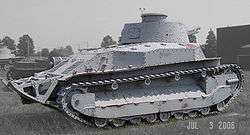
The IJA decided that the Type 87 Chi-I was too heavy at 20 tons and too slow to be used as its main tank. The Type 89 Chi-Ro (also known as the Type 89 I-Go) was developed to overcome these shortcomings.[7] The new design weighed 12.8 tons and used stronger and lighter steel plate instead of the Type 87's iron armor. Armament was a Type 90 57 mm gun, along with two Type 91 6.5mm machine guns.[37] The Type 89 design was completed in 1929, with production starting in 1931, making this the first tank to be mass-produced in Japan.[38] The Type 89 had two variants - the Kō ("A"), which used a water-cooled gasoline engine, and the Otsu ("B"), with an air-cooled diesel engine and improved frontal armor.[38] Of the two versions, a total of 113 Kō tanks and 291 Otsu tanks were produced.[35] The Type 89 was deployed for operations in the Second Sino-Japanese War. It served with Japanese infantry divisions before that, and first saw combat use in China during the First Battle of Shanghai in 1932.[39] It was in the process of being replaced by the Type 97 Chi-Ha by the start of World War II.
Type 95 Ha-Go light tank
.jpg)
The Type 95 Ha-Go (also known as the Type 97 Ke-Go)[40] was a replacement for the Type 89 medium tank which was considered too slow for mechanized warfare. The prototypes were built by Mitsubishi and production was started in 1936, with 2,300 completed by the end of the war.[41] It was armed with a 37 mm main gun and two 7.7 mm (0.303 inch) machine guns, one in the rear section of the turret and the other hull-mounted. The Type 95 weighed 7.4 tons and had three crewmen.[42][43]
It served throughout the Pacific Theater, including China and on many Pacific islands, such as Guadalcanal, the Marianas, and Iwo Jima. Several variants were built, among them the prototype Type 3 Ke-Ri, which mounted a 57 mm Model 97 gun, the Type 4 Ke-Nu light tank and the Type 5 Ho-Ru, a prototype self-propelled gun similar to the German Hetzer, but with a Type 1 47 mm tank gun.[44]
Type 98 light tank

The Type 98 light tank Ke-Ni (九八式軽戦車 ケニ Kyuhachi-shiki keisensha Ke-Ni) was designed to replace the Imperial Japanese Army's Type 95 Ha-Go light tank. It is also referred to as the Type 98 Chi-Ni light tank by some sources.[45] Although developed in 1938 to address deficiencies in the Type 95 design already apparent from combat experience in Manchukuo and China in the Second Sino-Japanese War. The prototype of the new Type 98 tank was completed in 1939. However, production did not begin until 1942. With the start of World War II, the Imperial Japanese Army General Staff quickly realized that the Type 95 design was vulnerable to heavy machinegun fire (.50 caliber), and as such attempted to develop a light tank with the same weight as the Type 95, but with thicker armor.[46] The Type 98 had a two-man turret, an improvement on the asymmetrical turret used on the Type 95, carrying a Type 100 37mm tank gun, with a muzzle velocity of 760 m/s, and with a coaxial 7.7 mm machine-gun to the side. A total of 104 Type 98s are known to have been built: 1 in 1941, 24 in 1942 and 79 in 1943.[17] One prototype variant built was the Type 98 Ta-Se, an anti-aircraft tank which mounted a converted Type 98 20 mm AA machine cannon.[47]
Type 2 Ke-To light tank
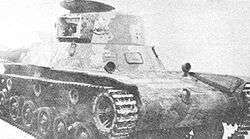
The Type 2 Ke-To Light Tank (二式軽戦車 ケト Nishiki keisensha Ke-To) was developed by the Imperial Japanese Army during World War II as an improvement on the existing Type 98 Ke-Ni. Development work on the Type 2 proceeded with an improved Type 1 37mm gun in an enlarged turret.[46] However, production did not commence until 1944, and by that date Japan was desperate for steel (largely due to US submarine warfare). This, combined with the American strategic bombing campaign, which laid waste to the industrial infrastructure, which, when added to the IJN's priority for warship construction, made it clear to the military that the highly successful Type 95 light tank would maintain its precedence on the assembly lines. The Type 2 tank production was placed on hold, and only 34 units were completed by the end of the war.[48] The war ended before any Type 2s were used in combat.
Type 4 Ke-Nu light tank
The Type 4 light tank Ke-Nu (四式軽戦車 ケヌ Yon-shiki keisensha Kenu) was an innovation created to increase the number of light tanks available to front-line infantry divisions of the Imperial Japanese Army in World War II. Through the modernization of Type 97 Chi-Ha medium tanks, in which its 57 mm gun turrets were replaced with 47 mm high velocity gun turrets, the 57 mm turrets were then available to install on Type 95 Ha-Go light tank hulls; thus creating a new light tank.[46]
The original version of the Type 97 Chi-Ha medium tank had been armed with a low muzzle velocity 57 mm tank gun. Operational experience in 1939 revealed that this gun was inadequate against opposing armor, and a new higher velocity 47 mm tank gun was developed. This gun was then installed in the Type 97 Chi-Ha medium tank to produce the Type 97-Kai Shinhoto version,[49] which became the standard main battle tank of the Japanese Army. This left a large number of surplus Type 97 Chi-Ha turrets, which were later retrofitted onto the chassis of the obsolete Type 95 Ha-Go tank, which had been armed with a 37 mm tank gun. The result was designated the Type 4 Ke-Nu. In total, approximately 100 units were converted in 1944.[50]
Type 97 Chi-Ha medium tank
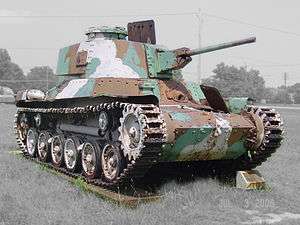
The Type 97 medium tank Chi-Ha (九七式中戦車 チハ Kyunana-shiki chu-sensha chiha) was the most widely produced Japanese medium tank of World War II, with about 25 mm thick armor on its turret sides, and 30 mm on its gun shield, considered average protection in the 1930s.[51][52] The 57 mm main gun was a carry over from the 1933 Type 89 medium tank, and was designed to support the infantry, while the 170 hp diesel Mitsubishi was a capable engine for the tank in 1938.[53] The number of Type 97 medium tanks produced was slightly lower than the output of Type 95 Ha-Go light tanks, but larger than any other medium tank fielded by Japan.
Some 3,000 examples of the Type 97 Chi-Ha were produced by Mitsubishi, including several types of specialized tanks. Initially armed with a low-velocity Type 97 57 mm tank gun, but from 1942 on-wards, the Model 97 was equipped with a high-velocity Type 1 47 mm tank gun, mounted in a larger turret.[54] This version was designated Shinhoto Chi-Ha ("new turret")[55] and is considered by many to be one of the best Japanese tank designs of the war. The Type 97 ShinHoTo Chi-Ha first saw action at Corregidor Island of the Philippines in 1942.[56] It went on to serve against allied forces throughout the Pacific and East Asia as well as the Soviets during the July–August 1945 conflict in Manchuria.[51] While vulnerable to opposing Allied tanks (US M3 Lee/British M3 Grant, M4 Medium and T-34), the 47 mm high-velocity gun did give the Type 97 Shinhoto Chi-Ha a fighting chance against them.[16]
Type 1 Chi-He medium tank

The Type 1 Chi-He was developed in 1942 to replace the Type 97. The newer tank proved to be superior to the Type 97 in both speed and armor protection, but production did not begin until 1943, due to the higher priority of steel allocated to the Imperial Navy for warship construction. A total of 170 units were built from 1943–44, but they did not see any combat as they were allocated to the defense of the Japanese home islands.[57] The three-man turret and 47 mm gun of the Type 1 were retrofitted on the hull of the Type 97 which the factories were already producing. Even so, production of the tank was discontinued after less than one year in favor of the Type 3 Chi-Nu medium tank.[58]
Type 3 Chi-Nu medium tank

The Type 3 Chi-Nu medium tank was urgently developed to counter the American M4 Sherman medium tank. Originally, the next tank in development to replace the Chi-He was the Type 4 Chi-To medium tank. However, the development of the Chi-To and the Type 5 Chi-Ri heavy tank were delayed, and a stopgap tank was required.[59] The development of Chi-Nu started in May 1943 and was finished by October. The low priority given tanks, along with the raw material shortages meant that the Type 3 did not enter production until 1944.[60] The Chi-Nu retained the same chassis and suspension of the Type 97 but with a large new hexagonal gun turret and a commander's cupola.[61] The main armament, a Type 3 75 mm tank gun, was based on the Japanese Type 90 field gun.[62] The Chi-Nu was the last IJA tank deployed and production continued until the end of the war. The tank was allocated to the Japanese home islands to defend against the projected Allied Invasion.[58]
Type 4 Chi-To medium tank
The Type 4 medium tank Chi-To (四式中戦車 チト Yonshiki chūsensha Chi-To) was one of several new medium and heavy tanks developed by the Imperial Japanese Army towards the end of World War II. It was the most advanced Japanese wartime tank to reach the production phase.[63]
The Type 4 Chi-To was a thirty-ton, all-welded tank with a maximum armor thickness of about 75 mm. It was much larger than the Type 97 Chi-Ha, with a longer, wider, tall chassis, supported by seven road wheels.[20][64] The main armament, a Type 5 75 mm tank gun, was based on the Type 4 75 mm AA Gun, which was in turn essentially a copy of a Bofors Model 1929 75 mm AA Gun, housed in a large powered, well-armoured hexagonal gun turret along with a coaxial machine gun. A single Type 97 heavy tank machine gun was mounted in the front hull, but there was no machine gun mounted to the rear of the turret. Only two Type 4 Chi-To tanks were completed prior to the end of the war, with an additional four chassis being manufactured. Neither of the completed units saw combat use.[65]
Type 5 Chi-Ri medium tank
The Type 5 medium tank Chi-Ri (五式中戦車 Go-shiki chusensha Chi-ri) was the ultimate medium tank developed by the Imperial Japanese Army in World War II. Intended to be a heavier, lengthened, more powerful version of Japan's sophisticated Type 4 Chi-To medium tank, in performance it was designed to surpass the US M4 Sherman medium tanks being fielded by the Allied forces. It was to be powered by a "Kawasaki Type 98 800 HP engine Ha-9-IIb" detuned for the tank to 550 hp. Originally, the tank was to be fitted with the same Type 5 75 mm tank gun used on the Type 4 Chi-To.[66][67] Eventually, an 88 mm gun (based on the Type 99 88 mm AA Gun) was planned for the turret; a secondary weapon of a front hull-mounted Type 1 37 mm tank gun was fitted in the position normally taken by a machine gun.[20][66]
As with many innovative weapons projects launched by Japan in the final days of World War II, production could not advance due to material shortages, and the loss of Japan's industrial infrastructure to the allied bombing of Japan. The single prototype Type 5 was seized by American forces during the occupation of Japan.[68]
Experimental Type 5 Ho-Ri tank destroyer

The Ho-Ri was a more powerful tank destroyer (gun tank) using a 105 mm cannon in place of the 75 mm design and an additional 37 mm gun. It was to use the Type 5 Chi-Ri tank chassis. The superstructure for the main gun was placed at the rear and the engine was to be placed in the center area of the chassis.[69] Another version was to have a twin 25 mm anti-aircraft gun on top of the rear superstructure.[70] No prototypes were built.[71]
O-I superheavy tank
The O-I experimental superheavy tank had three turrets and weighed 120 tons, and required a crew of 11 men. It was 10 meters long by 4.2 meters wide with an overall height of 4 meters. The armor was 200 mm at its maximum, and the tank had a top speed of 25 km/h. It had two gasoline engines, and was armed with 1 x 105 mm cannon, 1 x Type 1 47 mm gun (in a forward-mounted sub-turret), and 3 x Type 97 7.7 mm machine guns (one mounted in a forward sub-turret).[72] It has been reported the one prototype of the O-I was manufactured in 1943. However, the tank was "unpractical" and the project ended. No images of the O-I are known to exist.[72]
Amphibious tanks
.jpg)
During the 1930s and 1940s, the Japanese designed and produced several amphibious tank designs.[73] The Imperial Navy planned a major campaign in the Pacific with amphibious operations and thereby needed vehicles which could support the landings.[74] The tanks produced, included the Type 1 Mi-Sha, Type 2 Ka-Mi, Type 3 Ka-Chi, and Type 5 To-Ku; while other amphibious transports included the F B Swamp Vehicle, Type 4 Ka-Tsu APC, Toku 4 Shiki Naikatei APC, and the SRII Ro-Go. All of these for use by the Japanese Special Naval Landing Forces. The Type 1 was an early experimental design, that led to the Type 2 Ka-Mi, which was based on the Type 95 Ha-Go light tank. The Type 2 Ka-Mi was the first production Japanese amphibious tank, although beginning in 1942 only 182 to 184 units were built.[17][75]

The Type 3 Ka-Chi amphibious tank was based on an extensively modified Type 1 Chi-He tank and was a larger and more capable version of the earlier Type 2 Ka-Mi amphibious tank.[76] Only 19 Type 3 Ka-Chi tanks were built during the war.[77] The Type 3 Ka-Chi proved useful due to its capacity to be submarine launched, which enabled it to accommodate the increasingly difficult task of daytime reinforcement isolated for island garrisons in the South Pacific and in Southeast Asia. The tanks were used later in the war as dug-in pillboxes on Pacific islands. The Type 5 To-Ku was a large and heavy prototype based on the Type 5 Chi-Ri and Type 3 Ka-Chi; it boasted extensive armor protection and was fitted with a Type 1 25 mm gun and front hull mounted a Type 1 47 mm tank gun.[78]
Tank destroyers and assault guns
Type 1 Ho-Ni I Gun tank
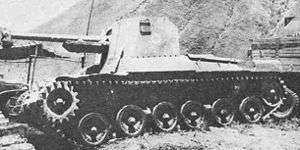
The Type 1 Gun tank Ho-Ni I (一式砲戦車 ホニ I, Isshiki ho-sensha Ho-NiI?) was a tank destroyer developed by the Imperial Japanese Army for use during World War II in the Pacific theater. As units of the Imperial Japanese Army began to encounter advanced Allied medium tanks, such as the M4 Sherman, it was seen that the Japanese Type 97 Chi-Ha main battle tank lacked sufficient armor or armament to deal with this threat, and work was begun on a tank destroyer version.[79]
The Type 1 Ho-Ni I was developed by utilizing the existing Type 97 chassis and engine, and replacing the gun turret with a 75 mm Type 90 Field Gun mounted in an open casemate with frontal and side armour only, which made it very vulnerable in close combat.[79] The Type 1 Ho-Ni I was designed to operate as self-propelled artillery in the armored divisions.[80][79] The mounting for the 75 mm Type 90 field gun allowed for ten degrees of traverse and elevation from -5 to +25 degrees.[80]
One variant produced was known as the Type 1 Ho-Ni II which mounted a Type 91 105 mm howitzer. It had a slightly changed superstructure as far as the side armor with re-positioned observation visors.[81]
Type 2 Ho-I Gun tank
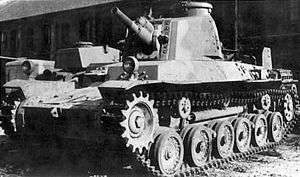
The Type 2 Gun tank Ho-I (二式砲戦車 ホイ Ni-shiki hōsensha Ho-I) Support Tank was a derivative of the Type 97 Chi-Ha medium tanks of the Imperial Japanese Army in World War II. Similar in concept to early variant of the German Panzer IV, it was designed as a self-propelled howitzer to provide the close-in fire support for standard Japanese medium tanks with additional firepower against enemy anti-tank fortifications.[82]
After experience in the war in China, Japanese planners wanted an armored vehicle with a larger weapon would be useful against fortified enemy positions such as pillboxes. They began work on mounting a Type 41 75 mm Mountain Gun onto the chassis of the Chi-Ha medium tank. The adapted mountain gun, known as the Type 99 75 mm tank gun, was completed in 1940. In 1942, the short barreled Type 99 75 mm gun was fitted into a Type 97-Kai gun turret which led to the Type 2 Ho-I.[83] As secondary armament there was a single 7.7 mm Type 97 heavy tank machine gun in the hull.[84] The tank utilized the chassis of the Type 1 Chi-He.[83] By 1942, the Japanese Army began to encounter the Allied M4 Sherman and M3 Stuart tanks, with which they could barely cope. The design parameters on the Type 2 were then changed to include a tank destroyer role, with its 75 mm gun equipped with armor-piercing shells.[83]
Type 3 Ho-Ni III tank destroyer

The Type 3 Ho-Ni III (三式砲戦車 ホニIII San-shiki hōsensha) gun tank was a tank destroyer and self-propelled artillery of Imperial Japanese Army in World War II. The Type 3 No-Ni II superseded the Type 1 Ho-Ni I in production, and was much safer for the crew due to its having a completely enclosed superstructure.[79] The Type 3 Ho-Ni III utilized the chassis of the earlier Type 97 Chi-Ha medium tank.
The main armament of the Type 3 Ho-Ni III was a Type 3 75 mm tank gun, based on the 75 mm Type 90 Field Gun, which was also used in the Type 3 Chi-Nu tank.[20][60] Previous gun tanks, Type 1 Ho-Ni I and Type 2 Ho-I, were not really optimized designs. The fully enclosed and armored casemate of the Type 3 Ho-Ni III was intended to address these issues, and an order of 57 was placed with Hitachi Ltd in early 1944.[79] Production was hampered by material shortages, and by the bombing of Japan in World War II, and only 31 to 41 were completed.[85][86] The Type 3 Ho-Ni III tank destroyers were assigned to various combat units, most stationed within the Japanese home islands to defend against the projected Allied Invasion. As the surrender of Japan occurred before that invasion, there is no record of the Type 3 Ho-Ni III ever being used in actual combat.[85]
Type 5 Na-To tank destroyer

The Type 5 Na-To (五式砲戦車 Go-shiki hōsensha) was the penultimate tank destroyer developed by the Imperial Japanese Army in the closing stages of World War II. The Type 5 Na-To made use of the chassis of the Type 4 Chi-So medium tracked carrier. The superstructure had an open top and rear, with an enclosed armored drivers cab. There was a "shielded platform" for its main gun.[87] Its main anti-tank armament consisted of a Type 5 75 mm tank gun which was the same gun that was used on the Type 4 Chi-To tank; a variant of the Japanese Type 4 75mm AA Gun.[88][89][90]
Towards the end of the Pacific War, Japanese field commanders realized that nothing in the inventory of the Japanese Army would be able to withstand the increasingly advanced tanks and armored vehicles fielded by the Allies, and that a more powerful version of the Type 3 Ho-Ni III was necessary. Development was rushed through on a new design, which was completed in 1945.[88] The Japanese Army immediately issued an order for 200 units to be completed in 1945.[90] However, by that time production was impossible due to material shortages, and the bombing of Japan in World War II, and only two units were completed by the surrender of Japan. Neither was used in combat.[91][90]
German-influenced variants
Throughout the war Germany supplied blueprints, technological support, and some examples of their tanks to Japan in accordance with the Tripartite Pact signed by the Axis powers. Some of knowledge shared with Japan inspired or influenced later Japanese armored vehicles, for example:
- Type 3 Chi-Nu medium tank, roughly equivalent to Panzer IV tanks.
- Type 4 Chi-To medium tank with Type 5 75 mm tank gun; a variant of the Type 4 75 mm AA Gun, inspired by the Panther tank.
- Type 5 Chi-Ri heavy tank with Type 99 88 mm AA Gun, inspired by the Tiger I.
- Type 1 Ho-Ha halftrack, inspired by the SdKfz 251
- O-I superheavy tank and experimental ultraheavy tank, equivalent to the Panzer VIII Maus
Post World War II tanks
Japanese Type 61 tank

The Type 61 (Japanese: ろくいちしきせんしゃ Kanji: 61式戦車) was a main battle tank (MBT) developed and used by the Japan Ground Self-Defense Force (JGSDF), built by Mitsubishi Heavy Industries.Development started in 1955 and the vehicle was first deployed in April 1961. The type number follows the year of deployment. A total of 560 Type 61's were manufactured between 1961 and 1975, when production ceased. The Type 61 is conventionally laid out, with a central turret and the engine located at the rear of the hull. The tank has a crew of four, a commander, driver, gunner and loader. The hull is welded steel, with a cast steel turret. The maximum armour thickness is quoted as 64 millimeters. A 12.7 mm machine gun was normally mounted on the cuppola for anti-aircraft use. The main gun was the Type 61 90 millimeter caliber rifled gun with a horizontal sliding breach block. The gun is fitted with a t-shaped muzzle brake, which diverts firing gasses sideways, and reduces the amount of dust kicked up by firing. A coaxial 7.62 millimeter machine gun is mounted next to the gun.
Japanese Type 74 tank
.jpg)
The Type 74 (74式戦車 nanayonshikisensha) is a main battle tank (MBT) of the Japan Ground Self-Defense Force (JGSDF). It was built by Mitsubishi Heavy Industries as a replacement for the earlier Type 61. It was based on the best features of a number of contemporary designs, placing it in the same class as the US M60 Patton or German Leopard 1. Like these designs, it mounts the M68 105 mm gun. The design did not enter widespread use until 1980, by which point other western forces were starting the introduction of much more capable designs.
Japanese Type 90 tank

The Type 90 tank (90式戦車 Kyūmarushikisensha) is the current main battle tank (MBT) of the Japan Ground Self-Defense Force (JGSDF). It is built by Mitsubishi Heavy Industries and was designed as a replacement for all deployed Type 61s and a portion of their Type 74 tanks, and entered service in 1990. It is slated to be complemented by the Type 10. The Type 90 mounts a licensed copy of the German Rheinmetall L44 120 mm smoothbore cannon product by Japan Steel Works Limited. This is the same gun that is mounted on the German Leopard 2, American Abrams, and the South Korean K1A1 tanks. The gun is armed and loaded through a mechanical bustle autoloader (conveyor-belt type), developed by Mitsubishi of Japan. The Type 90 tank is the first western tank to achieve manpower savings by reducing the crew to three through the development of the turret bustle autoloader (With the exception of the turretless Strv 103).[92] This design allows the tank crew to operate without a loader, which allows the use of a smaller turret.
Japanese Type 10 tank

The Type 10 (10式戦車 Hitomarushikisensha) is a 4th generation main battle tank produced by Mitsubishi Heavy Industries for the Japanese Ground Self Defense Force (JGSDF). Compared with other currently-serving main battle tanks in the JGSDF, the Type 10 has been equipped with enhancements in its capability to respond to anti-tank warfare and other contingencies.[93] The Type 10 is to replace or complement the existing Type 74 and Type 90 main battle tanks that are currently in service. Development began in the 1990s, with a prototype revealed in February 2008. In January 2012, thirteen Type 10 tanks entered JGSDF service. The vehicle's armor consists of modular components which significantly improves the side armor compared to the Type 90. The Type 10 uses the same 120 mm smoothbore gun as the Type 90, which is made by Japan Steel Works.[23] The gun fire newly developed APFSDS, type 10 APFSDS. Type 10 can fire JM33 APFSDS or all standard 120 mm NATO ammunition. However, Type 10 APFSDS is specifically designed for and can only be fired by the Type 10's gun.[94]
Notes
- ↑ Zaloga 2007, p. 12.
- ↑ Taki's Imperial Japanese Army
- ↑ Zaloga 2007, p. 4.
- ↑ Foss. Tanks: The 500. p. 220
- 1 2 Tomczyk 2002, pp. 6, 7.
- 1 2 Tomczyk 2002, p. 7.
- 1 2 Tomczyk 2002, pp. 7, 10, 17.
- ↑ Zaloga 2007, p. 5.
- ↑ Zaloga 2007, p. 6.
- 1 2 Zaloga 2007, p. 8.
- 1 2 3 Tomczyk 2002, p. 46.
- ↑ Tomczyk 2002, pp. 29, 30.
- 1 2 Tomczyk 2002, p. 30.
- ↑ Taki’s Imperial Japanese Army: Type 95 Heavy Tank
- 1 2 3 Rottman & Takizawa 2008, p. 59.
- 1 2 Tomczyk 2005, p. 61.
- 1 2 3 Zaloga 2007, p. 17.
- ↑ Zaloga 2007, p. 15.
- ↑ Tomczyk 2005, pp. 3, 5, 29.
- 1 2 3 4 Zaloga 2007, p. 22.
- ↑ Antill, P. (2001). "Type 61 Main Battle Tank".
- ↑ "Japanese Ground Forces". GlobalSecurity.org.
- 1 2 3 "Type 10 Tank of Japan Ground Self Defense Force". Global Military Review. Retrieved 3 April 2015.
- ↑ Tomczyk 2002, pp. 7, 10.
- ↑ Zaloga 2007, p. 7.
- ↑ Coox 1985, pp. 154, 157.
- ↑ Tomczyk 2002, pp. 46, 54.
- ↑ Tomczyk 2002, pp. 39, 46.
- ↑ Report on Type 92 from September 1945 issue of Intelligence Bulletin
- 1 2 Taki’s Imperial Japanese Army: Type 94 Disinfecting Vehicle and Type 94 Gas Scattering Vehicle
- 1 2 Coox 1985, p. 157.
- 1 2 Tomczyk 2002, p. 55.
- ↑ Foss. Tanks: The 500.
- ↑ Zaloga (Armored Thunderbolt) pp. 15, 18
- 1 2 Zaloga 2007, p. 10.
- ↑ Japan's Tankette Type 97 Te-Ke / Ke-Ke, WWIIVehicles.com.
- ↑ Tomczyk 2002, pp. 19, 25.
- 1 2 Zaloga 2007, pp. 5, 6.
- ↑ Tomczyk 2002, p. 27.
- ↑ Tomczyk 2002, p. 64.
- ↑ Zaloga 2007, pp. 10, 17.
- ↑ Tomczyk 2002, pp. 67, 74.
- ↑ Zaloga 2007, p. chart D.
- ↑ Zaloga 2007, pp. 18, 19, 20.
- ↑ History of War: Type 98 Light Tank
- 1 2 3 Zaloga 2007, p. 18.
- ↑ Tomczyk 2007, p. 14.
- ↑ Zaloga 2007, pp. 17, 18.
- ↑ Zaloga 2007, pp. 12, 13, 14.
- ↑ History of War: Type 4 Ke-Nu
- 1 2 Tomczyk (II) 2007, p. 19.
- ↑ Zaloga 2007, p. 11.
- ↑ Zaloga 2007, pp. 10, 11.
- ↑ Zaloga 2007, pp. 13, 14.
- ↑ Zaloga 2007, p. 14.
- ↑ Zaloga 2007, p. 16.
- ↑ Zaloga 2007, pp. 17, 23.
- 1 2 Zaloga 2007, pp. 21, 22.
- ↑ Taki's IJA: "Tanks after Chi-Ha"
- 1 2 Tomczyk 2005, p. 3.
- ↑ Tomczyk 2005, pp. 3, 32.
- ↑ Tomczyk 2005, pp. 3, 5.
- ↑ History of War: Type 4 Chi-To
- ↑ Tomczyk 2005, pp. 19, 20.
- ↑ Tomczyk 2005, pp. 19, 20–22, 30.
- 1 2 History of War: Type 5 Chi-Ri Medium Tank
- ↑ Tomczyk 2005, pp. 29, 30.
- ↑ Tomczyk 2005, p. 23.
- ↑ Tomczyk 2007, p. 30.
- ↑ Tomczyk 2007, p. 31.
- ↑ Tomczyk 2007, pp. 30, 31.
- 1 2 Taki’s Imperial Japanese Army page: Super-Heavy Tank "O-I"
- ↑ Tomczyk 2003, p. 3.
- ↑ Tomczyk 2003, p. 4.
- ↑ Taki's IJA: Type 2 Amphibious Vehicle "Ka-Mi"
- ↑ Zaloga 2007, pp. 23, 24.
- ↑ Taki's IJA: "Type 3 Amphibious Tank Ka-Chi"
- ↑ Tomczyk 2003, pp. 32, 33, 43.
- 1 2 3 4 5 Zaloga 2007, p. 19.
- 1 2 Tomczyk 2007, p. 3.
- ↑ Tomczyk 2007, pp. 10, 20.
- ↑ History of War: Type 2 Ho-I Gun Tank
- 1 2 3 Zaloga 2007, p. 21.
- ↑ Taki’s Imperial Japanese Army: Type 2 "Ho-I"
- 1 2 Zaloga 2007, pp. 19, 20.
- ↑ Taki's Imperial Japanese Army: Type 3 Gun Tank "Ho-Ni III"
- ↑ Tomczyk 2007, pp. 10, 12–13, 38.
- 1 2 Tomczyk 2007, p. 10.
- ↑ Tomczyk 2005, pp. 22, 30.
- 1 2 3 Taki’s Imperial Japanese Army: 75mm SP AT Gun "Na-To"
- ↑ Zaloga 2007, p. 20.
- ↑ Type 90 Tank -GlobalSecurity.org
http://www.globalsecurity.org/military/world/japan/type-90.htm - ↑ Introduction of the aircraft Type 10 tank -Japanese Ministry of Defense, Japan Defense Focus No.33 Column, Oct 2012
http://www.mod.go.jp/e/jdf/no33/column.html - ↑ Japanese MOF report
References
- Coox, Alvin D. (1985). Nomonhan: Japan Against Russia, 1939. Two volumes. Stanford University Press. ISBN 978-0-8047-1160-9.
- Foss, Christopher (2003). Tanks: The 500. Crestline. ISBN 0-7603-1500-0.
- Rottman, Gordon L.; Takizawa, Akira (2008). World War II Japanese Tank Tactics. Osprey Publishing. ISBN 978-1846032349.
- Tomczyk, Andrzej (2002). Japanese Armor Vol. 1. AJ Press. ISBN 83-7237-097-4.
- Tomczyk (II), Andrzej (2007) [2002]. Japanese Armor Vol. 2. AJ Press. ISBN 978-8372371119.
- Tomczyk, Andrzej (2003). Japanese Armor Vol. 3. AJ Press. ISBN 978-8372371287.
- Tomczyk, Andrzej (2005). Japanese Armor Vol. 4. AJ Press. ISBN 978-8372371676.
- Tomczyk, Andrzej (2007). Japanese Armor Vol. 5. AJ Press. ISBN 978-8372371799.
- Zaloga, Steven J. (2007). Japanese Tanks 1939–45. Osprey. ISBN 978-1-8460-3091-8.